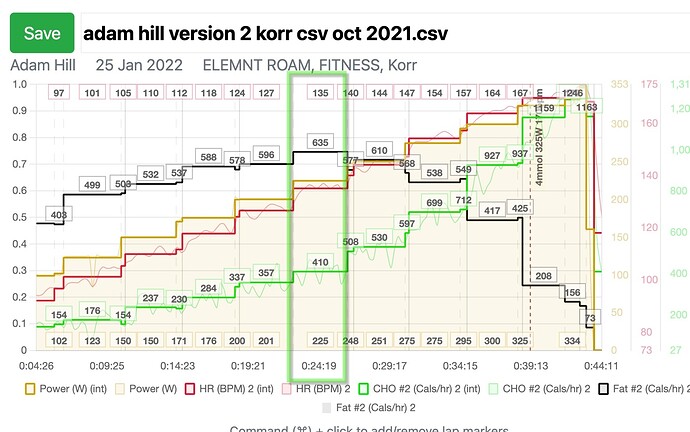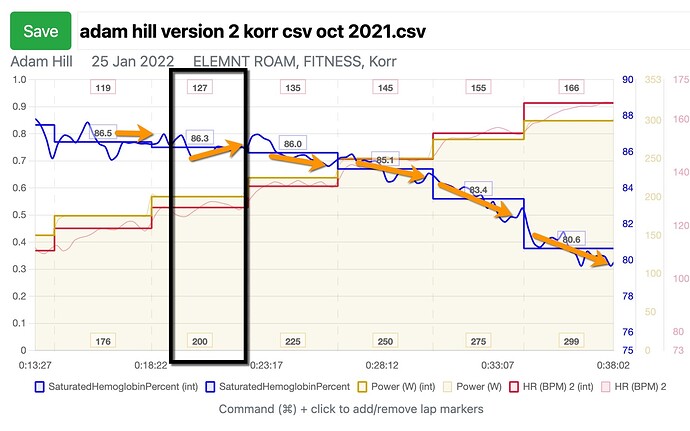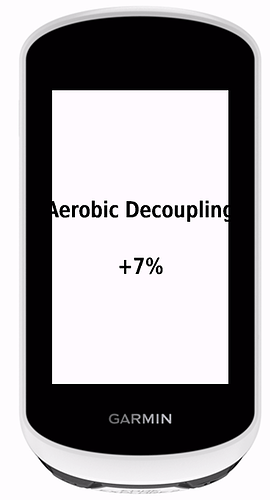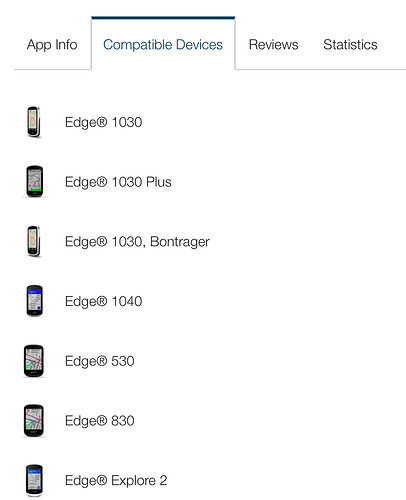I might be able to add this to my moxy data field? Let me have a look, I have always wanted this as well.
@steveneal you mentioned using a Moxy monitor to determine zone 2 heart rate training range (and I guess other HR zones as well). How do you use a Moxy monitor to determine zone 2 range, and is that something any rider can do or does it need specific (advanced) training to use? If I should start a new topic on this, please let me know.
Thanks.
In short, using a moxy, smo2 is either;
- rising relative to stable power
- stable relative to stable power
- decreasing relative to stable power
The final point where it would be rising relative to stable power would be aerobic threshold.
Here is an example of an athlete with lactate, moxy, fat and carb utilization.
You will see that the fatmax and lactate deflection happen at 225 watts, the moxy is rising until 200w. I use the lactate deflection or the fatmax as ceilings for the endurance training zone. So therefore the athlete would train just below this, where smo2 would be rising.
So you can actually use the moxy during a session to see if it is rising, stable or decreasing relative to stable power.
I’ve got started on a Garmin IQ data field for aerobic decoupling.

- Default warm up period is 20 mins and can be changed in data field settings.
- Default period to be compared for decoupling is 30 mins, and can be changed in data field settings.
- First 30 mins (if unchanged from defaults) after warm up is baseline
Don’t know how long it’ll be. When I find time to code. Then I’ll want to go for a ride to give it a test. I’m clear in my head what needs to be done.
Anyway, watch this space.
Phil
If you are interested in a Moxy, if you use SteveNeal in the coupon code section, you get a discount of 5% off the regular price. I just bought one and did so, haven’t received it yet. And Steve gets a small commission:)
@steveneal In Adam Hill’s file the lactate, fax max and Sm02 came in around the same, between 127-135 HR and between 200 and 226 watts. Would you use the Moxy to see if on a particular day you would have him do closer to 200 versus 226 watts, and would that change during the ride depending on his tiredness, etc?
Also, if unlike these files, there was a larger gap in another rider between lactate, Sm02, and Fax Max, which one would you give priority to for long aerobic base rides?
Yes, that is exactly what I do. Find that zone everytime you want to do that type of session.
There won’t be.
This will always be relative to the athlete.
The moxy will be the same as the persons fatmax, which will be one stage below the atheltes LT1.
Fat max is one step below the lactate deflection, due to the fact that when carbs starts to increase, therefore so does lactate, and fat will drop relatively.
On the smo2, this would be last stable wattage level that there is a positive slope.
@micomico thanks! I need to read up on the Moxy and see if I think I will understand it well enough to get the value from it.
There won’t be.
This will always be relative to the athlete.
So is there a need then to do lactate testing, fat max if there the numbers are about the same as the Sm02 for each athlete?
I am in your shoes, northk, maybe a couple of steps ahead, been doing my due diligence as far as my baseline ignorance of all this allows.
A good place to go is the sparecycles blog by Jem Arnold. And there are youtube videos with him and others that go pretty deep in the bushes with this (monotonic versus parabolic responses, etc.)
Steve Neal has all his clients using Moxy, and has metabolic carts, lactate testing, and has been posting about Moxy for a long time.
He also does a one-hour consulting on Moxy as needed. Once I get my unit and do the basic testing, I plan on consulting with him from time to time to see how it can help me. You can private message him if interested.
There have been times, such as this mournful morning, when I go out and do an easy endurance ride, around 65% of max HR, and find my Power/HR coming down pretty quick. But I feel fine, no change in RPE. When I get home my Training peaks shows a big decoupling (hopefully soon Phil will help us see this in realtime once he does his code magic on Garmin).
So I overdid it, not low enough HR it seems. Moxy, I hope, would show my declining Sm02 real-time and I could make adjustments as it was beginning to happen.
Up and running in the simulator. Warm up 1 minute, aerobic baseline duration of 1 minute. Tomorrow it’ll hopefully get out for a ride to see real data, with the defaults of 20 min warm up, 30 min aerobic baseline.
OK so hopefully instead of a new thread I will post this here, per Hunter Allen: Polarized Training is not for the average Joe: Why Polarized training is NOT for you! - Shop Peaks Coaching Group
His point is interesting so what do the smart folks on here that know way more than I think of his point, it is better to work in the 80-90% FTP range vs polarized…to quote from his article:“this distribution would look like the traditional bell curve, 10% Recovery, 25% Endurance, 35% Tempo, 15% FTP, 10% VO2, 5% Anaerobic and Neuromuscular power. Which means that the majority of your training is done in the tempo zone, which equates to 76-91% of your FTP. The “sweetspot” intensity is 88-93% of FTP and blends the upper end of Tempo and the lower end of FTP, crossing both zones. In the traditional method, you will want to spend a good portion of your training at “sweet spot” as well. There IS a lot of good research that this approach to training works and works well.”
I thought this was a great article as well.
I think a lot of distribution for an athlete’s intensities can come from the cycling sport they take part in, and how much group riding they do.
I have periods where some of my road riders do group riding to get ready for some races and/or add some more fun into the training.
These types of rides have a very similar distribution of power to that of Hunter’s article.
Most of the athletes I work with are getting ready for MTB XC 90m races (2-4 a year), 2 stage races per year, some longer gravel racing. So in that mix I have always found a combo of polarized and pyramidal training (if I have to give it a name, has worked best to bring consistent results over years.
Something important I take from this is that when working with a coach, they will have a philosophy. The good coaches will be able to work different types of people into slightly different philosophies to make them fast.
Not everyone I coach can handle the same kind of training to improve. Two different athletes racing minutes apart in a stage race both training differently to get to that performance.
Understanding all of the different nuances of philosophies, what everyone means as a training zone, where someone has their athletes train in that training zone, how good the relationship is between the coach and athlete (how much trust does the athlete have in the process), are just some of the things that can make different training philosophies work for different athletes.
Interesting topic. I feel like I’m reading about myself. I’m 56 and my HR numbers are almost identical to that of the original poster.
Five years ago now I tried polarized as defined by some of the early Fasttalk podcasts with Seiler. I believe Seiler was saying 65% of HRmax as a guesstimate of Z1/2 boundary.
For me, this came out at a ridiculously low 119bpm. When I first tried this I was literally riding about at 10mph to keep my HR under 119. I quickly upped this to 125bpm to be practical and I was still riding around at a really slow 12mph.
I wanted to try a polarized base over the winter because I was stuck, often tired, not getting faster and I didn’t know what to do. Based on the early podcasts I thought I’d try this. I started at 6 hours per week and ramped up over 12 weeks to 13 hours per week. I did one 2-3 hour group ride per week as my only form of intensity. The other hours were riding around @ 125 bpm.
What happened?
First my speed at 125bpm increased over the weeks from the 12mph to 16-17-18mph. I noticed that my HR across the board during the group ride was much lower. We’d be moving along at a fast clip and I could sit in comfortably @ 125-135bpm and feel like I was doing nothing. I was staying much fresher throughout the group ride.
By week 8 of ‘polarized base’, I was breaking every single personal PR I was tracking on Strava. In particular I was tracking all out 3 minute, 8 minute and 20 minute climbs that we’d do every week on the group ride.
At 8 weeks though I topped out and didn’t improve any more even though I continued the plan for 12 weeks.
Fast forward to last year, I wanted to try something different. I was intrigued by @steveneal 's tempo intervals.
Starting in Oct, I did a lot of 125bpm zone 2 and not much else. (Coincidentally, I later triangulated my 125bpm with the talk test (San Millan) and DFA a1 (HRV4Training / Bruce Rogers). And @ 125bpm I hit square in the middle of my Z2 power on WKO5.
In January, I started doing Steve’s tempo intervals (3x20min) and building out to a few 4x20 sessions by the end of March. I was doing tempo sessions twice per week. Whenever I tried 3x per week, it was too much. I also made the mistake of not having regular easy/rest weeks and fell apart after 8 weeks which then mandated a week off.
I decided to try a short VO2 max block in the spring (April) and I hit my best numbers ever after all these tempo intervals. WKO5 modeled my best ever mFTP that spring and I felt stronger than ever during group ride season.
Steven can correct me if I’m wrong but I think the tempo intervals work like building out TTE which is something I had never specifically done before.
Here is the tempo topic:
Hello @AJS914
Yes you have it correct.
If I use a heart rate rate for the tempo it would 78-83% for most people.
I think this kind of tempo pushes the fat combustion up and to the right (the lactate curve would be getting flatter for longer.
In a perfect world this would happen but you would still be able to hit near your max lactate as well, therefore not really missing any pieces of the puzzle.
So yes I guess TTE would improve.
I think when people try and polarize their training, and they don’t have a strong aerobic system, training 60-70% is too easy, likely has to be more like 70-75% … and after time when the stroke volume comes along the power will come up and the heart rate will drop, then you can start using the 60-70% heart rate training zone and will likely work like magic.
I appreciate you sharing your experience of trying the stuff I chat about.
The other thing is eventually you will be able to do longer pieces of tempo like I prescribe, then put days back to back to back. This is when things can get really interesting.
The secret for me is going back and forth between this type of training as main focus (with some above threshold maintenence, for physical reasons but also the mental reasons of remember how to suffer). Then when the vo2 power stops increasing from this type of training, hit a block of intensity and push that ceiling up.
Again, thanks for sharing your experience.
I think whether you do Polarised or Sweetspot assuming you are not a pro is as much about mindset and what kind of events you do as anything. I quite like the long easy ride, I find it quite meditative.
I’m not sure why he thinks training falls off a cliff with Polarised in the winter as well. Sure if you are snowbound for 4 months of the year you are not going to get many long easy rides in. But that doesn’t apply to the whole of the northern (or southern) hemisphere. In the UK you can get out for your long winter rides most weeks in winter. If you are snowbound you’ve got cross country skiing.
What holds many of us back, I suspect, is that we are unwilling to experiment. If we do experiment with our training, we don’t give it long enough, expecting results in 8 weeks because we’ve read a study. Thus we go back to what we’ve always done, and that keeps us on a fitness plateau. We may be happy at that fitness plateau, it’s enough for what we do.
I think we see the most progress when we no longer see these training regimes as a sacred religion. When we look honestly at how we’ve progressed over the years with the training style we’ve adopted, whether, if we are on a fitness plateau, we want to get off it, and how much work and change (to our training) we are prepared to put in.
Be prepared to try Polarised, Sweetspot, Pyramidal but commit to trying it for a longer timescale and see where you end up. Above all be consistent and honest with your compliance, and give it time, to assess progress.
For me durability is important, what I can do after many hours or days is important as my events are what you’d classify as ultra endurance. The long ride mostly at or below LT1 is the bread and butter of my events. It’s far from boring when that long easy effort takes you across countries or across continents. Polarised and Pyramidal approaches feel like a good fit for it.
Good points, Phil. You bring up a big mistake I have made, about training plateaus and not experimenting. Not being patient enough.
I am changing perspectives, and will be experimenting with a low aerobic base only program for around 5-6 months, more hours per week, following Philip Mafftetone, DC, recommendations, (The Big Book of Endurance Training and Racing) which parallel Steve House’s recommendations (uphillathlete.com).
All suggest no intervals, tempo, high intensity or weights during this period. That can be added later.
I am also incorporating Steve Neal’s advice on the use of a Moxy, which just arrived. Steve also mentioned noted Bob Seebohar’s Metabolic Efficiency program, so I started reading his book Metabolic Efficiency Training.
Of particular interest, Seebohar, after many years of testing athletes, found that to increase fat burning at higher levels of exertion , nutrition gives 75% of the result, and aerobic training only 25%. He says it is possible for athletes through nutrition and training to see their LT 1 shift as high in the 80’s % of max HR and still be in largely fat burning mode. Nutrition is key.
That may explain a recent post elsewhere by Steve who was asked to consult by the coach of a very fit, experienced cyclist. In the space of around 3 months her LT 1 shifted strikingly to the right. Steve changed her nutrition and her training plan, easier rides, using the food program by Bob Seebohar.
@AJS914 I feel your pain about going slow. Fpike used the phrase “stupid slow”. I live in a hilly place, and love riding into the mountains. So base riding is very slow. I weigh over 200 lbs, not much fat to lose, so the pace is so slow that frankly, I rationalized not doing it. You increased your riding hours substantially, so I wonder if any type of program would have brought you better results, regardless.
As for me, I just bought an eBike to give myself to pleasure of going at slow but not too slow and still stay at low HR levels.
Phil, can you make your decoupling available to the rest of us? I use a Garmin 530. thanks.
The Edge 530 is on the list of devices I have built it for.
I’m field testing it at moment and comparing to decoupling analysis in software once finished. It’s beta on the Connect iq App Store at moment which allows me to download it, and change the settings in the Connect iq app on phone connected to my Edge. Doesn’t seem to be a way to invite others into beta. I’ll see what I need to do next when I’m happy with my testing of it.
Thanks, please keep us posted as to when you have dialed it in, and what we could do to get it.






